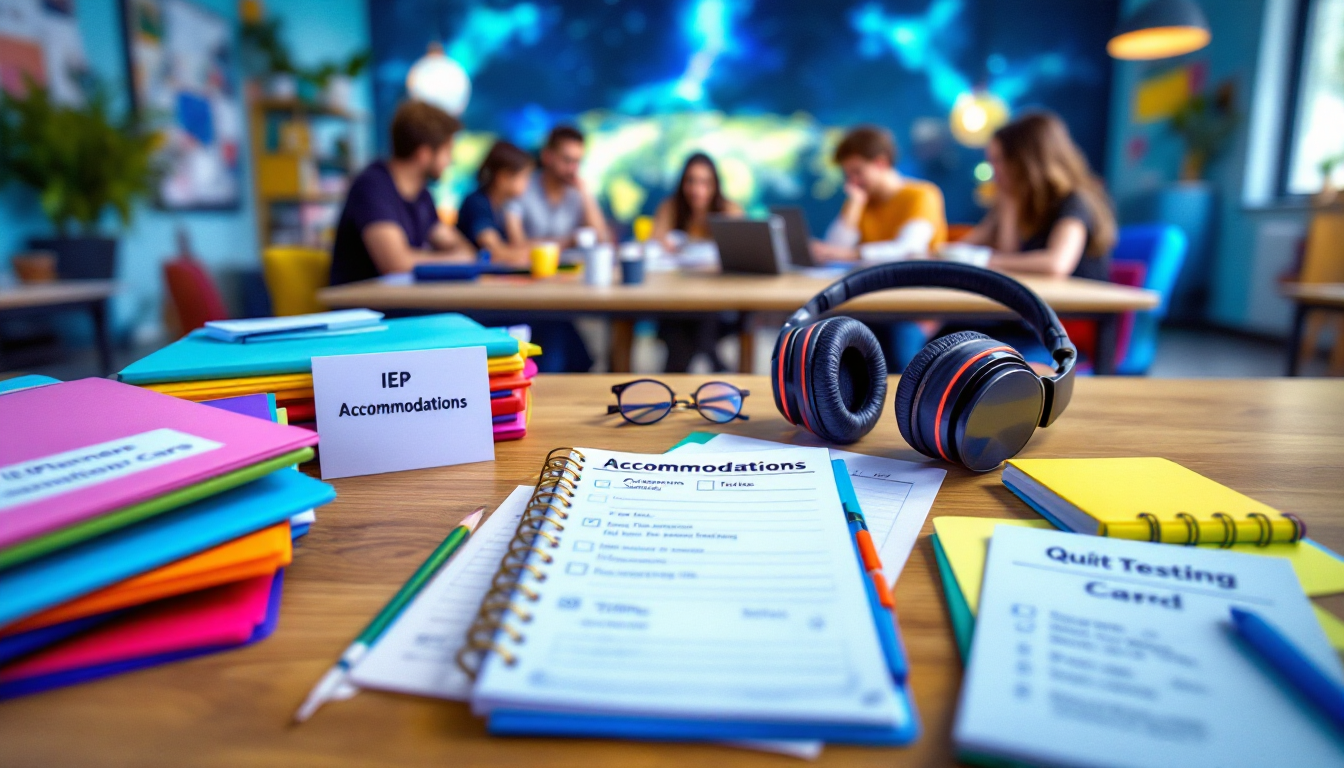ADHD and Executive Dysfunction in the Classroom

For many students, the traditional classroom environment can present significant hurdles. When a student has Attention-Deficit/Hyperactivity Disorder (ADHD), these challenges are often compounded by executive dysfunction. This guide aims to provide parents, teachers, special education professionals, and ADHD advocates with a supportive, informative, and accessible resource on understanding and managing ADHD and executive dysfunction in school. We'll explore how these intertwined conditions impact learning and offer practical, evidence-based strategies to foster a more inclusive and effective educational experience.
Understanding ADHD and Executive Dysfunction
To effectively support students, it's crucial to grasp the core concepts of ADHD and its close relationship with executive dysfunction.

What is ADHD?
ADHD is a neurodevelopmental disorder that affects how the brain regulates attention, impulsivity, and activity levels. It's not a behavioral choice but a difference in brain structure and function, particularly in areas responsible for executive functions. The symptoms typically emerge in childhood and can persist into adulthood.
ADHD is commonly categorized into three presentations:
-
Predominantly Inattentive Presentation: Students may struggle with focus, easily get sidetracked, have difficulty organizing, and often appear forgetful.
-
Predominantly Hyperactive-Impulsive Presentation: Students may exhibit excessive fidgeting, difficulty staying seated, talk excessively, and act without thinking.
-
Combined Presentation: Students show a significant number of symptoms from both the inattentive and hyperactive-impulsive presentations.
What is Executive Dysfunction and how is it connected to ADHD?
Executive functions are a set of mental skills that are controlled by the frontal lobe of the brain. They are the "management system" of the brain, enabling us to plan, focus attention, remember instructions, and juggle multiple tasks successfully. Executive dysfunction occurs when these skills don't work as efficiently as they should.
The connection between ADHD and executive dysfunction is profound. While not every person with executive dysfunction has ADHD, a vast majority of individuals with ADHD experience challenges with one or more executive functions. In fact, many of the observable behaviors associated with ADHD are direct manifestations of underlying executive dysfunction. It's not a separate condition but rather a core feature of how ADHD impacts daily functioning, especially in demanding environments like a classroom.
Key Executive Functions Commonly Impaired
Several executive functions are frequently impaired in students with ADHD, directly affecting their ability to thrive in academic settings:
-
Working Memory: This is the ability to hold information in mind and use it to complete a task. Students may struggle to remember multi-step instructions, recall facts for tests, or keep track of what they've already done in a longer assignment.
-
Task Initiation: The ability to start tasks, especially those that are perceived as difficult or undesirable. Students might procrastinate, stare blankly at an assignment, or seem "stuck" when faced with a new task.
-
Organization: The skill of managing materials, information, and time. This can manifest as a messy backpack, disorganized notes, difficulty structuring essays, or losing track of deadlines.
-
Planning and Prioritization: The capacity to set goals, outline steps, and determine what's most important. Students may jump into tasks without a plan, struggle to break down large projects, or misjudge the time needed for assignments.
-
Self-Regulation/Emotional Regulation: The ability to manage emotions, impulses, and behavior to achieve goals. Students might experience heightened frustration, emotional outbursts, difficulty coping with setbacks, or struggle to control impulsive actions.
-
Time Management: The ability to estimate, allocate, and monitor time effectively. Students may be chronically late, rush through assignments, or underestimate how long tasks will take.
-
Metacognition: The ability to think about one's own thinking, including self-monitoring and self-correction. Students might not recognize when they're making errors or understand how their actions impact their learning.
How Executive Dysfunction Shows Up in the Classroom
The impact of executive dysfunction in the classroom is often visible through a range of behaviors that can be puzzling or frustrating to educators who don't understand the underlying cause.
-
Difficulty following multi-step instructions: A teacher might give a three-part instruction ("Take out your math book, turn to page 25, and complete problems 1-5"), but the student only completes the first step or gets lost after the second. This isn't defiance, but a working memory overload.
-
Forgetting homework or losing materials: Backpacks might resemble black holes, and assignments frequently go missing. This is often due to poor organization and planning skills, not a lack of caring.
-
Struggles with transitions and time management: Moving from one subject to another, switching activities, or managing independent work time can be incredibly challenging. Students might get "stuck" in one activity or have difficulty shifting their focus, leading to missed instructions or incomplete tasks. Time blindness—difficulty accurately perceiving the passage of time—is also common.
-
Emotional outbursts or frustration intolerance: When tasks are overwhelming due to executive function deficits, students may become easily frustrated, leading to meltdowns, crying, or lashing out. This isn't necessarily a behavioral problem but an emotional regulation challenge stemming from an inability to cope with the demands.
-
Appearing "spacey" or disengaged: Students with working memory challenges may seem to be daydreaming or not paying attention, when in reality, they've lost the thread of the conversation or forgotten what they were supposed to be doing.
-
Rushing through work or making careless errors: Due to poor planning and self-monitoring, students might complete assignments quickly without checking for accuracy, leading to many mistakes.
-
Difficulty starting tasks even when they know what to do: This can look like procrastination, but it's often a struggle with task initiation, where the "getting started" part feels insurmountable.
Common Misinterpretations by Educators

Without an understanding of executive dysfunction, educators may inadvertently misinterpret these behaviors, leading to ineffective interventions or negative assumptions about a student's character or motivation.
-
"Lazy" vs. "Struggling to initiate": When a student consistently avoids starting work, it's easy to label them as lazy or unmotivated. However, for a student with executive dysfunction, the effort required to initiate a task—especially one without immediate gratification—can be immense. They might genuinely want to do the work but are neurologically "stuck."
-
"Unmotivated" vs. "Overwhelmed by executive demands": A student who appears indifferent to grades or completing assignments might not be unmotivated but rather overwhelmed by the sheer executive demands of managing multiple tasks, deadlines, and organizational needs. The task feels insurmountable, leading to shutdown or avoidance.
-
"Disrespectful" or "Defiant" vs. "Difficulty with emotional regulation/impulse control": Emotional outbursts, interrupting, or blurting out answers can be perceived as intentional disrespect. However, these are often direct results of impaired emotional regulation and impulse control, where the student struggles to inhibit their immediate reactions.
-
The danger of zero-tolerance discipline approaches: While classroom management is essential, rigid zero-tolerance policies can be particularly harmful to students with ADHD and executive dysfunction. These approaches often punish the symptom (e.g., missed homework, talking out of turn) without addressing the underlying cause (e.g., poor organization, impulse control). This can lead to increased anxiety, a sense of failure, and disengagement from school, rather than promoting learning or behavior change. It's crucial to differentiate between willful defiance and executive function challenges.
Strategies for Supporting ADHD Students in the Classroom

Fortunately, many effective strategies can help students with ADHD and executive dysfunction navigate the classroom more successfully. These approaches focus on externalizing executive functions, providing structure, and reinforcing positive behaviors.
-
Visual schedules and timers: For students who struggle with transitions and time management, visual schedules (e.g., pictures or written lists of daily activities) provide clear expectations. Timers (visual or auditory) help students develop a better sense of time and stay on task.
-
Breaking tasks into smaller steps: Large assignments can be overwhelming. Teach students to break them down into manageable chunks. Provide checklists for multi-step tasks. For example, instead of "Write an essay," try "Brainstorm ideas," "Create an outline," "Write introduction," etc.
Flexible seating and fidget tools: Allowing students to choose seating that helps them focus (e.g., near the teacher, away from distractions) can be beneficial. Fidget tools (e.g., stress balls, fidget spinners) can help channel excess energy and improve focus for some students, as long as they are not distracting to others.
Provide clear and concise instructions: Give one or two instructions at a time, checking for understanding after each. Write instructions on the board or provide them in a handout. Ask students to repeat instructions in their own words.
Utilize organizational aids: Provide folders, binders, and designated spots for materials. Help students regularly clean out and organize their desks and backpacks. Color-coding subjects can also be helpful.
Positive reinforcement and goal-setting: Focus on what the student does well and provide specific praise for effort and progress, not just perfection. Help students set small, achievable goals (e.g., "I will complete 3 math problems without getting distracted"). Use reward systems or token economies to motivate.
Check-ins and prompts: Regularly check in with students to see if they're on track. Provide verbal or visual prompts to help them refocus or initiate tasks. "What's your next step?" or "Where should you be now?"
Collaboration with parents and school counselors: Consistent communication between home and school is vital. Share strategies that work at school with parents and vice-versa. School counselors can offer additional support through individual or group counseling on executive function skills.
Reduce distractions: Consider seating the student away from high-traffic areas, windows, or talkative peers. Provide noise-canceling headphones for independent work.
Teach self-monitoring strategies: Encourage students to check their work, ask themselves if they understand, and identify when they need help.
Classroom Accommodations and IEP/504 Considerations

For students with ADHD and significant executive dysfunction, formal accommodations may be necessary to ensure equitable access to education. These are often outlined in an Individualized Education Program (IEP) or a 504 Plan.
Common accommodations for executive dysfunction
-
Extended time on assignments and tests: Allows students to process information and complete tasks without feeling rushed.
-
Reduced workload: Fewer problems or shorter assignments to focus on quality over quantity.
-
Preferential seating: Placing the student in a location that minimizes distractions and maximizes their ability to focus.
-
Use of a daily planner/agenda: Support in using and checking a planner to track assignments and due dates.
-
Notes provided by teacher or peer: To compensate for difficulties with note-taking or working memory.
-
Frequent breaks: Allowing movement or short mental breaks to help with sustained attention.
-
Verbal reminders and visual cues for tasks and transitions: Reinforcing instructions and upcoming changes.
-
Access to fidget tools: As previously mentioned, for self-regulation.
-
Opportunity to take tests in a quiet environment: To minimize distractions during high-stakes assessments.
-
Use of technology: Word processors for writing, calculators for math, or assistive technology for organization.
Examples of realistic, classroom-friendly supports
Many accommodations can be seamlessly integrated into the regular classroom routine without disrupting the flow:
-
Providing a "work folder" for incomplete assignments: Helps keep track of what needs to be done.
-
Breaking down multi-page worksheets into single pages: Reduces visual overwhelm.
-
Using a "check-in" system before independent work: A quick verbal check to ensure the student understands the task.
-
Designating a "launchpad" area for materials needed for the next activity: Helps with transitions.
-
Allowing standing or movement breaks: A quick stretch or walk to the pencil sharpener can help re-regulate.
Advocating for an inclusive learning environment
Parents and advocates play a critical role in ensuring that schools recognize and address the needs of students with ADHD and executive dysfunction. This involves:
-
Understanding your child's rights: Familiarize yourself with the Individuals with Disabilities Education Act (IDEA) and Section 504 of the Rehabilitation Act.
-
Documenting concerns: Keep records of observations, communications with the school, and academic performance.
-
Requesting evaluations: If you suspect ADHD or executive dysfunction is impacting your child's learning, formally request a school evaluation.
-
Participating in IEP/504 meetings: Be an active member of the team, advocating for appropriate accommodations and services.
-
Educating school staff: Share resources and information about ADHD and executive dysfunction to foster a deeper understanding.
Tools and Resources for Teachers
Beyond general strategies, specific tools and resources can further empower teachers to support students with ADHD and executive dysfunction.
-
Apps and planners that help with task tracking:
-
Remind apps: Apps like Google Keep, Todoist, or even basic calendar apps can help students and teachers manage deadlines and assignments.
-
Organizational apps: Tools like Trello or dedicated student planners (digital or physical) can help break down projects.
-
Focus apps: Apps like Forest or Pomodoro timers can help students stay focused for set periods.
-
-
ADHD-friendly curriculum supports:
-
Differentiated instruction: Tailoring teaching methods and materials to meet diverse learning needs, including those with ADHD.
-
Multi-sensory learning: Incorporating visual, auditory, kinesthetic, and tactile elements into lessons to engage different learning styles.
-
Project-based learning: Engaging students in hands-on, long-term projects that allow for more flexibility and autonomy.
-
Curricula that explicitly teach executive function skills: Some programs focus on teaching organizational strategies, planning, and self-regulation.
-
-
Teacher training programs for neurodiversity:
-
Seek out professional development workshops and courses specifically on ADHD, executive functions, and neurodiversity-affirming practices.
-
Online courses, webinars, and conferences dedicated to special education and learning differences.
-
Resources from organizations like CHADD (Children and Adults with Attention-Deficit/Hyperactivity Disorder) and Understood.org provide valuable information and strategies.
-
Connecting with special education colleagues and school psychologists for their expertise.
-
Final Thoughts

Supporting students with ADHD and executive dysfunction in the classroom requires a shift in perspective. It's about understanding that challenges in attention, organization, and self-regulation are not character flaws or indicators of laziness, but rather brain-based differences that require specific, compassionate, and consistent support.
Reframing ADHD as a brain-based challenge, not a character flaw
When we view ADHD through a neurodevelopmental lens, it transforms how we approach interventions. Instead of asking, "Why isn't this student trying harder?" we ask, "What executive function skill is this student struggling with, and how can I provide the support they need?" This reframing fosters empathy and leads to more effective, supportive strategies.
Importance of empathy and consistency
Empathy allows educators to connect with students on a deeper level, understanding their struggles and celebrating their unique strengths. Consistency in applying accommodations, strategies, and behavioral expectations provides the predictability and structure that students with ADHD often thrive on. Inconsistency can heighten anxiety and undermine progress.
Encouragement for ongoing collaboration between home and school
The most successful outcomes for students with ADHD and executive dysfunction occur when there is a strong partnership between home and school. Open communication, shared strategies, and a united front in supporting the student's growth are paramount. By working together, parents and educators can create an inclusive and empowering learning environment where every student, including those with ADHD, has the opportunity to reach their full potential.
Ultimately, by understanding, accommodating, and advocating for students with ADHD and executive dysfunction, we can transform the classroom into a place where they not only survive but truly thrive.


